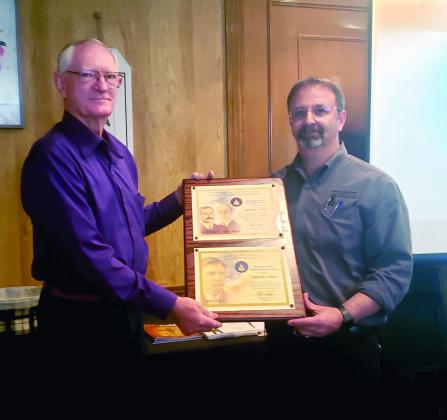When Darrell Mize first started flying airplanes, Neil Armstrong was still a few years away from taking his historic first step on the surface of the moon.
This past weekend, Mize was recognized by the Federal Aviation Administration for his experience in aviation — both as a pilot and as a mechanic — when he received the FAA’s Wright Brothers Master Pilot Award and the Charles Taylor Master Mechanic Award. Both awards are presented to pilots who have at least 50 years’ experience in the given field.
Mize said he was 23 when he started flying in 1966.
“I just started flying at Colorado City,” he said. “All my life I’ve always wanted to know how things work and all, so after I got my pilot’s license I got the mechanic’s license so that I could work on the plane and see how it operates.”
Dan Vengen of the Federal Aviation Administration Safety Team (FAAST) said he doesn’t give out 50-year certificates frequently.
“We gave a master pilot and a master mechanic award, which is 50 years as an aircraft mechanic, and 50 years as a certified aircraft pilot,” Vengen said. “Not everybody makes it to 50 years in aviation. He’s still qualified to fly, which is an awesome thing. Most people start flying when they’re 20, anywhere from 16 to 20, so 50 years later, all these people are in their 70s, and I have given these awards to people all the way up to about 92 years old.”
Mize said he never flew for the military.
“I applied for the Air Force in the pilot’s area. At that time, they said my eyesight wasn’t good enough,” he said. “They said I could qualify for the back seat (typically a support role in a fighter aircraft), and I said, ‘Nah, I really wanted to be on the front (the pilot’s seat).’ So I backed off and that was the extent of that.”
Mize said he started working on airplanes in the Snyder area.
“We’d test-fly them quite often after we worked on them,” he said. “I just started building up time on different airplanes and adding ratings as I went. I started flying for a construction company and built up quite a bit of time with them. I carried the executives to the yards, and they’d do their thing. Mainly just worked and flew the planes for them. During that time, I was also an instructor, a flight instructor. I obtained the inspector rating for the aircraft, and on the company plane I flew it, inspected it and worked on it, so I kept the whole thing in the local area.”
The freedom to travel as he wishes is the best part of being a pilot for Mize.
“Seeing the country and meeting people at the other end, from different areas of the United States,” he said. “They have kind of different cultures and it’s neat to see the differences. And the weather. When you’re flying you have different weather nearly every time you go, and it’s great to see the beauty of nature, so to speak.”
Mize said he has a little over 10,000 hours flying various aircraft, most of it on a Piper 31-325 Navajo, a cabin-class, twin-engine aircraft.
These days, Mize said he enjoys flying a glider.
“That glider, the yellow one,” he said, pointing to a picture of the craft. “It’s just a challenge. It’s a low-performance glider, and it’s a challenge to go out and get back without going down somewhere.”
Image
Body


